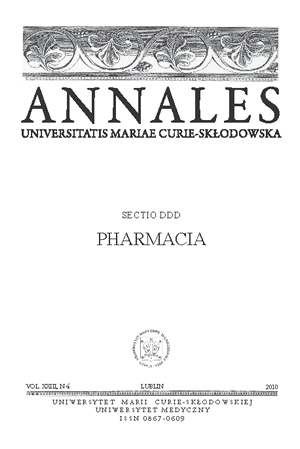Wpływ łącznego podawania simwastatyny i amitryptyliny na wybrane parametry biochemiczne w surowicy krwi szczurów
Słowa kluczowe:
simwastatyna, amitryptylina, parametry biochemiczneAbstrakt
W pracy oceniano wpływ łącznego 14-dniowego i.p. podawania szczurom simwastatyny i amitryptyliny na wybrane parametry biochemiczne w surowicy krwi, świadczące o funkcji wątroby i nerek szczurów. Oznaczano aktywność AST i ALT oraz stężenie AFP, białka całkowitego, mocznika, kreatyniny i β2-mikroglobuliny. Na podstawie otrzymanych wyników stwierdzono, że 14-dniowe podawanie szczurom simwastatyny w kombinacji z amitryptyliną powoduje zmiany w oznaczanych parametrach biochemicznych. Wydaje się, że możliwa jest długotrwała łączna terapia simwastatyną i amitryptyliną, ale pod warunkiem systematycznej kontroli parametrów świadczących o funkcji wątroby i nerek.
Bibliografia
1. Bottorf M.B.: Statin safety and drug interactions: clinical implications. Am. J. Cardiol., 97, 27C , 2006.
2. Chalasani N., Hisham A., Kesterson J., Murray M. D., Hall S. D.: Patients with elevated liver enzymes are not at higher risk for statin hepatotoxicity. Gastroenterology, 126, 1287, 2004.
3. Chalasani N.: Statins and hepatotoxicity: focus on patients with fatty liver. Hepatology, 41, 690, 2005.
4. Charles E.C., Olson K.L., Sandhoff B.G., McClure D.L., Merenich J.A.: Evaluation of cases of severe statin-related transaminitis within a large health maintenance organization. Am J Med, 118, 618, 2005.
5. Cohen D.E., Anania F.A., Chalasani N.: An Assessment of Statin Safety by Hepatologists. Am. J. Cardiol., 97, S77, 2006.
6. Gibson K., Rindone J.P.: Experience with statin use in patients with chronic hepatitis C infection. Am. J. Cardiol., 96, 1278, 2005.
7. Herman R.J.: Drug interactins and the statins. CMAJ, 161 9100, 1281, 1999.
8. Hyogo H., Tazuma S., Arihiro K., et al.: Efficacy of atorvastatin for the treatment of nonalcoholic steatohepatitis with dyslipidemia. Metabolizm, 57, 1711, 2008.
9. Jacobson T.A.: Statin Safety: Lessons from New Drug Applications for Marketed Statins. Am J Cardiol, 97, S44, 2006.
10. Karnik N.S., Maldonado J.R.: Antidepressant and statin interactions: a review and case report of simvastatin and nefazodone-induced rhabdomyolysis and transaminitis. Psychosomatics, 46, 565, 2005.
11. Kasiske B.L., Wanner C., O’Neill W.C.: An Assessment of Statin Safety by Nephrologists. Am. J. Cardiol., 97, S82, 2006.
12. Kassimatis T. I., Konstantinopoulos P.A.: The role of statins in chronic kidney disease (CKD): Friend or foe?. Pharmacol. Ther., 312, 2009.
13. Kim J. S., Schmid-Burgk W., Claus D., Kornhuber H.H.: Effevts of Amitriptyline on Serum Glutamate and Free Tryptophan in Rats. Arch. Psychiatr. Nervenkr., 232, 391, 1982.
14. Maddrey W.C.: Drug-induced liver disease: 2006. The risk profile of statins. American Association for the Study of the Liver disease. Annual Meeting, Boston 2006.
15. Mitchell D.B., Acosta D.: Evaluation of the cytotoxicity of tricyclic antidepressants in primary cultutes of rat hepatocytes. J. Toxicol. Environ. Health, 7, 83, 1981.
16. Paoletti R., Corsini A., Bellosta S.: Pharmacological interaction of statins. Atherosclerosis, (Suppl. 3), 35, 2002.
17. Patassini S., Giampa C., Martorana A., Bernardi G., Cusco FR.: Effect of simvastatin on neurorotection and modulation of Bcl-2 and BAX in the rat quinolinic acid model of Huntington´s disease, Neurosci. Lett., 19, 166, 2008.
18. Ray K.K., Cannon C.: The potential relevance of the multiple lipid-independent (pleiotropic) effects of statins in the management of acute coronary syndromes. J. Am. Coll. Cardiol., 46, 1425, 2005.
19. Segarra-Newnham M., Parra D., Martin-Cooper E.M.: Effectiveness and hepatotoxicity of statins in men seropositive for hepatitis C virus. Pharmacoteraphy, 27, 845, 2007.
20. Skrabal M.Z., Stading J.A., Monaghan M.S.: Rhabdomyolysis associated with simvastatin-nefazodone therapy. South Med. J., 96, 1034, 2003.
21. Smith C.C., Bernstein L. I., Davis R.B. et al.: Screening for Statin-Related Toxicity: The Yield of Transaminase and Creatine Kinase Measurements in a Primary Care Setting. Arch. Intern. Med., 163, 688, 2003.
22. Talbert R.L.: Safety issues with statin therapy. J. Am. Pharm. Assoc., 46, 479, 2006.
23. Tousoulis D., Charakida M., Stefanadi E. et al.: Statins in heart failure. Beyond the lipid lowering effect. Intern. J. Cardiol., 115, 144, 2007.
24. Wang C.Y., Liu P.Y., Liao J.K.: Pleiotropic effects of statin therapy: molecular mechanisms and clinical results, Trends Mol. Med., 14, 37, 2008.
25. Wen B., M Li., Z. Mingshe.: Bioactivation of the tricyclic antidepressant amitriptyline and its metabolite nortriptyline to arene oxide intermediates in human liver microsomes and recombinant P450s. Chemico-Biological Interactions, 173, 59, 2008.
26. Wille S.M., Cooreman S.G., Neels H.M., Lambert W.E.: Relevant issues in the monitoring and the toxicology of antidepressants. Crit. Rev. Clin. Lab. Sci., 45, 25, 2008.
Pobrania
Opublikowane
Numer
Dział
Licencja
Prawa autorskie (c) 2010 Autorzy

Praca jest udostępniana na licencji Creative Commons Attribution-NonCommercial-NoDerivatives 3.0 Unported License.


